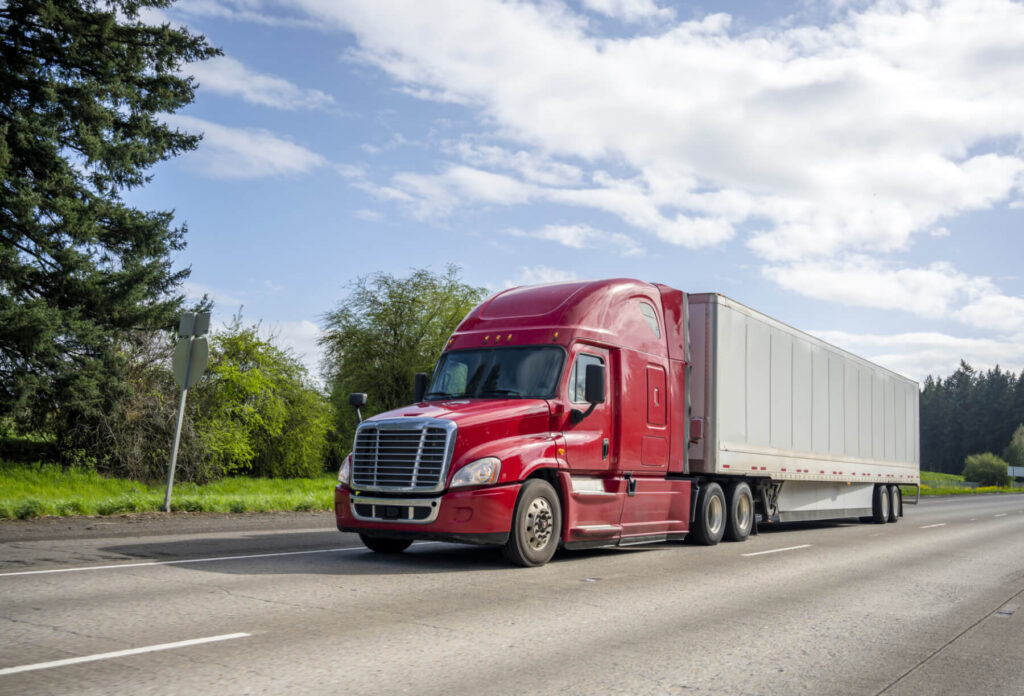Dry van transportation is a part of shipping and logistics that is very important. You might not have noticed it, but you’ve probably seen these big rectangular trailers on the highway a lot of times. The vans are everywhere, carrying all types of goods from one place to another.
In simple terms, dry van transportation involves using large, enclosed trailers to move stuff from point A to point B. These trailers are like very big boxes on wheels, and they’re very useful for a lot of things.

Whether it’s to carry electronics, clothing, or even food, dry van trailers can carry a different range of products, keeping them safe from weather and other things that can spoil them. This essay looks at the important things to know about dry van transportation.
The Basics: Characteristics of Dry Vans
Dry vans are very important in the logistics industry. Let’s explain in detail the most important characteristics or attributes of dry vans.
Description and Design
Dry vans are essentially large, rectangular boxes made of steel or aluminum. They have a roof, four walls, and a floor, and this creates an enclosed space to transport goods. The design is simple yet highly functional, providing a protective shell for cargo.
At the front of the dry van, you’ll find a set of sturdy double doors that swing open or slide open, allowing easy access to load and unload goods. These doors often have seals and locks to keep the cargo secure during transit.
Size and Capacity
Dry van trailers come in various sizes, but the most common ones are typically 53 feet in length. The width is usually around 8 feet, and the height can vary depending on the specific trailer model. Because of these dimensions and available space, dry vans are one of the most used methods of shipping items.
The capacity of a dry van trailer can also vary based on factors like weight limits and the type of cargo being transported. Weight rules must be followed to ensure safe and successful shipping.
Common Materials Used
Below are some of the materials that can be used to build a dry van.
1. Steel: Many dry van trailers are constructed from steel. Steel is very strong and is able to withstand the stress of long-distance transportation. However, steel trailers tend to be heavier, which can affect fuel efficiency.
2. Aluminum: Aluminum dry vans are lighter than their steel counterparts. This material is lightweight, and this saves the use of fuel and allows the vehicle to carry higher freight loads while remaining under the weight rules. Aluminum also prevents rusting, and this increases the life of the trailer.
3. Composite Materials: Some dry van trailers incorporate composite materials, such as fiberglass-reinforced plywood or other composite panels. These materials create the right balance between strength and weight, leading to a long-lasting and environmentally friendly option.
4. Insulation: In some cases, dry van trailers are equipped with insulation to protect temperature-sensitive cargo, like food or pharmaceuticals. Insulated dry vans help maintain a consistent interior temperature, preserving the quality of the products being transported.
Advantages of Dry Van Transportation
Dry van transportation has a lot of benefits that make a lot of people think of using it before thinking of any other trailer. Some of these benefits are given below:
Versatility
Dry van trailers are not rigid or used for just one type of industry, and they are able to carry different stuff for different companies. Whether you’re shipping electronics, clothing, furniture, or even non-perishable food items, dry vans can accommodate various types of cargo.
This ability to change depending on the conditions of things makes them the favorite for many industries, because it makes transporting different products within the same trailer very simple.
Security and Protection
One of the benefits of using a dry van for transportation is the security and protection it provides for what you are transporting. The enclosed design of dry vans protects goods from things that can spoil them, like rain, snow, wind, and dust.
Also, the strong doors on dry van trailers close tightly, which protects the cargo from being stolen, dropped on the way, and any changes that can spoil it while it is moving from one place to another. This type of protection is especially important for expensive things or those that are fragile or get spoiled easily.
Cost-Effectiveness
Dry van transportation is often cost-effective for shippers, carriers, and dry van shipping companies. These trailers are readily available, which helps keep transportation costs competitive. Additionally, their standardized design makes them easy to load, unload, and handle, reducing labor expenses.
Furthermore, dry vans are known for their fuel efficiency, thanks to their aerodynamic shape and lighter materials in some cases (e.g., aluminum), which can result in cost savings on fuel.
Accessibility
Dry van trailers are designed for accessibility. The double doors at the rear of the trailer provide straightforward access to the cargo. This accessibility streamlines the loading and unloading processes, making it efficient and reducing turnaround times. It’s also possible to load dry vans from the sides, allowing for more versatility in cargo handling.
Common Uses of Dry Van Transportation
Dry van transportation is used in different companies and enterprises to make sure that items arrive carefully and quickly. Here are some of the many common uses for dry van transportation:
Retail and Consumer Goods
Dry vans are used again and again for transporting retail and consumer goods. It may be clothing, electronics, appliances, or furniture, dry van trailers provide a secure and weather-resistant environment for these products.
Retailers rely on dry van transportation companies to refill their stores and meet up with customer’s orders, especially during peak shopping seasons.
Food and Beverage Industry
The food and beverage industry heavily relies on dry van transportation to move non-perishable food products. Dry vans can help ensure that canned foods, packaged snacks, drinks, and other non-perishable items arrive undamaged and free of contaminants. While temperature-controlled vehicles are used for goods that can be damaged quickly, dry vans are used for the industry’s non-perishable parts.
Automotive Industry
Dry van transportation plays a role that is not small in the automotive sector and companies. Car manufacturers use dry vans to carry parts of vehicles, components of vehicles, and even fully assembled vehicles.
The enclosed and secure environment of dry vans helps protect these valuable and often delicate items from damage while they are being taken from one place to another.
E-commerce and Online Retail
In the age of e-commerce and online retail, the demand for dry van transportation has surged. Amazon and other online shopping markets depend upon dry trucks to transport anything from gadgets and home items to toys and pet supplies.
Conclusion
Dry van transportation is not just versatile, but also cost-effective. It keeps transportation costs competitive, thanks to readily available trailers and standardized designs that reduce labor expenses. Fuel efficiency further adds to its cost-saving advantages.
Accessibility is another feather in the cap of dry van transportation, with easy loading and unloading processes and the flexibility to handle cargo from different angles.
So, the next time you see one of those big rectangular trailers on the highway, remember the essential role it plays in getting products from point A to point B safely and efficiently. Although using dry van transportation may not usually make the news, it is an important part of how the whole world and everyone connect through trade.







Leave a Comment
You must be logged in to post a comment.